1989 MITSUBISHI GALANT brake fluid
[x] Cancel search: brake fluidPage 728 of 1273

23-22 AUTOMATIC
TRANSAXLE
- Troubleshooting
Based upon use of the troubleshooting
guide, the probable location of the prob-
lem should be estimated.
Checks should be made of fluid levels
and the condition of the ATF, as well as
1 found to be necessary
.
the condition of the manual control ca-
bles; adjustments should then be made if
If a presumption has been made that
there is an abnormal condition some-
where in the electronic-control system,
check the fault code, in order to determine
the probable location of the problem, by using a scan tool or voltmeter.
When the abnormal system is discovered,
check each element (sensors, etc.) one by
one, and make repairs as necessary.
When the abnormal condition is pre- sumed to be in the oil-pressure-control
When the result of the oil-pressure test does not satisfy the specified pressure,
1 passages for leakage, etc
.
check each system at places related to
the valve body, check the oil-pressure
If the problem is unusually dirty ATF,
abnormal noises, oil leakage, or slippage
L##t he traniaxle.1
of the clutch or brakes or an abnormal
condition of the transaxle Itself,
disassem-
TROUBLESHOOTING
Functional malfunctions of the ELGWT can lead to other
problems,
such
as those described
below:
(1) Improper
maintenance
and/or
adjustments
(2) Malfunctions of the electronic control functions
(3) Malfunctions of mechanical functions
(4) Malfunctions of hydraulic control functions
(5) Malfunctions of engine performance
etc.
In order
to properly
determine (“Troubleshoot”)
the
source
of
these
malfunctions,
it is first essential
to methodically ques-
tion
the
user
concerning
the details
of the problem,
such as
the
condition of
the
problem,
the
situation at
the
time the
problem
occurred,
and any other relevant
information, all in as much detail
as possible.
The user
should
also be asked
whether or not the problem has occurred more than once,
and under
what conditions. Subsequently,
certain
tests should
be conducted in a certain
order,
as described
at
the
left.
1 TSB Revision
Page 732 of 1273
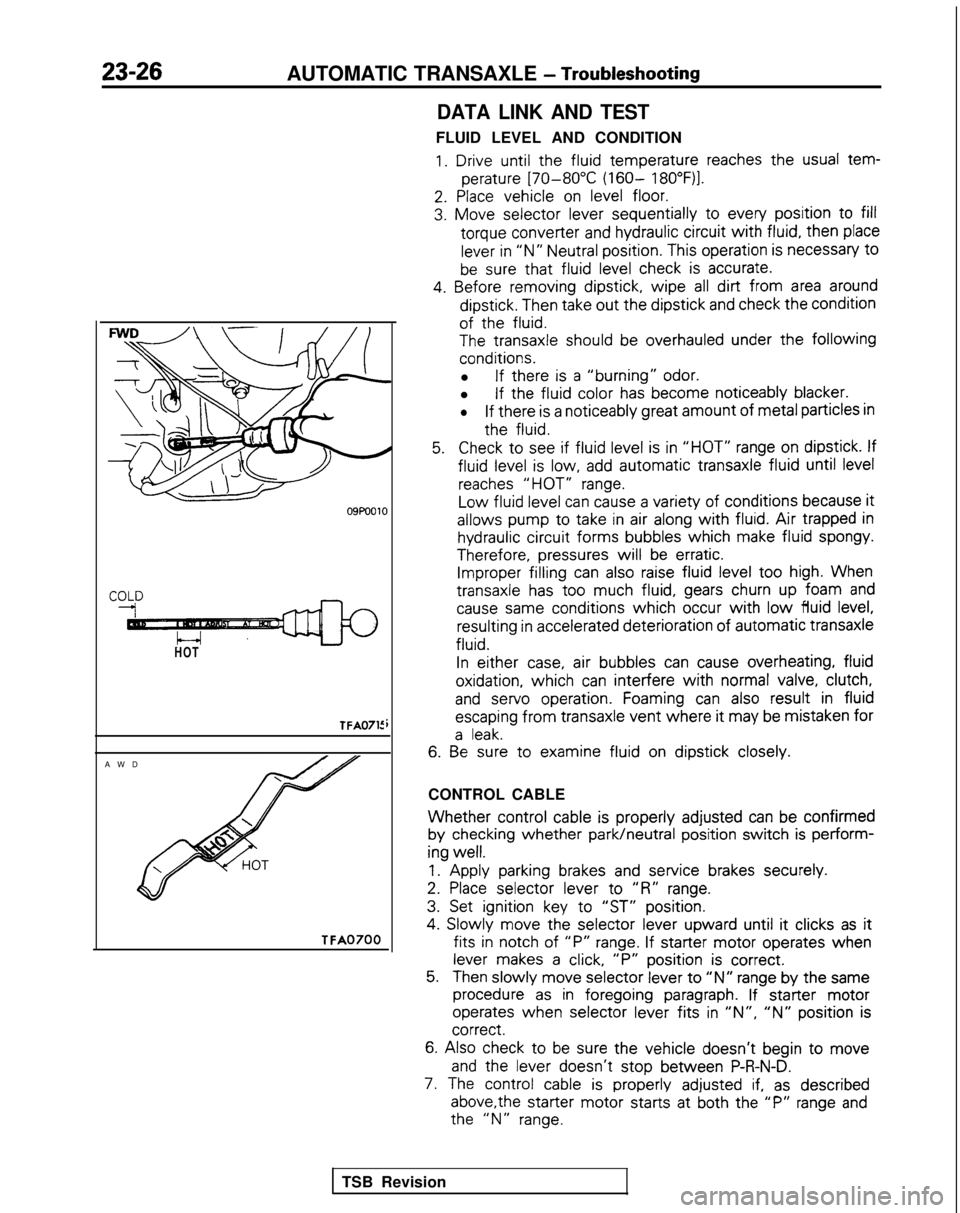
23-26AUTOMATIC TRANSAXLE - Troubleshooting
HOT
TFA0715
AW
D
TFA0700
DATA LINK AND TEST
FLUID LEVEL AND CONDITION
1. Drive until the
fluid
temperature
reaches the
usual tem-
perature
[70-80°C (160- 18O”F)l.
2. Place
vehicle
on level floor.
3. Move
selector
lever sequentially
to
every
position
to fill
torque
converter
and hydraulic circuit
with fluid,
then
place
lever in “N” Neutral position.
This operation is necessary
t0
be sure that fluid
level check is accurate.
4. Before
removing
dipstick,
wipe all dirt from area around
dipstick.
Then take out
the
dipstick
and check the
condition
of the
fluid.
The
transaxle
should be overhauled under the following
conditions.
l If there
is a “burning” odor.
l If the
fluid
color
has become
noticeably
blacker.
lIf there
is a noticeably
great
amount
of metal particles in
the
fluid.
5.Check to
see if fluid
level is in “HOT” range on dipstick.
If
fluid
level is low, add automatic
transaxle
fluid
until level
reaches “HOT” range.
Low
fluid
level can cause a variety of
conditions
because it
allows
pump
to
take
in air along with fluid. Air trapped in
hydraulic circuit
forms
bubbles
which
make fluid
spongy.
Therefore,
pressures
will be erratic. Improper filling
can also raise fluid level too
high. When
transaxle
has too
much fluid,
gears churn up foam and
cause same
conditions
which occur with low fluid
level, resulting
in accelerated deterioration
of
automatic
transaxle
fluid.
In
either
case, air bubbles
can cause overheating,
fluid
oxidation,
which can interfere
with normal valve, clutch,
and
servo
operation.
Foaming can also result
in fluid
escaping
from
transaxle
vent where it
may be mistaken
for
a leak.
6. Be
sure to
examine
fluid
on dipstick
closely.
CONTROL CABLE
Whether control
cable is properly
adjusted
can be confirmed
by
checking
whether park/neutral
position
switch is perform-
ing
well.
1.
Apply
parking brakes and service
brakes securely.
2. Place
selector
lever
to
“R” range.
3. Set ignition
key to
“ST” position.
4.
Slowly
move
the
selector
lever
upward
until it
clicks as it
fits in
notch of “P” range. If starter
motor
operates
when
lever makes a click, “P”
position
is correct.
5.Then slowly
move
selector
lever to “N” range by
the
same
procedure as in foregoing
paragraph. If starter
motor
operates
when selector
lever
fits in ‘IN”, “N” position
is correct.
6.
Also check to be sure the
vehicle
doesn’t
begin to move
and
the
lever
doesn’t
stop
between
P-R-N-D.
7. The control
cable is properly
adjusted if, as described
above,the
starter
motor
starts
at both the
“P” range and the
“N” range.
TSB Revision
Page 765 of 1273
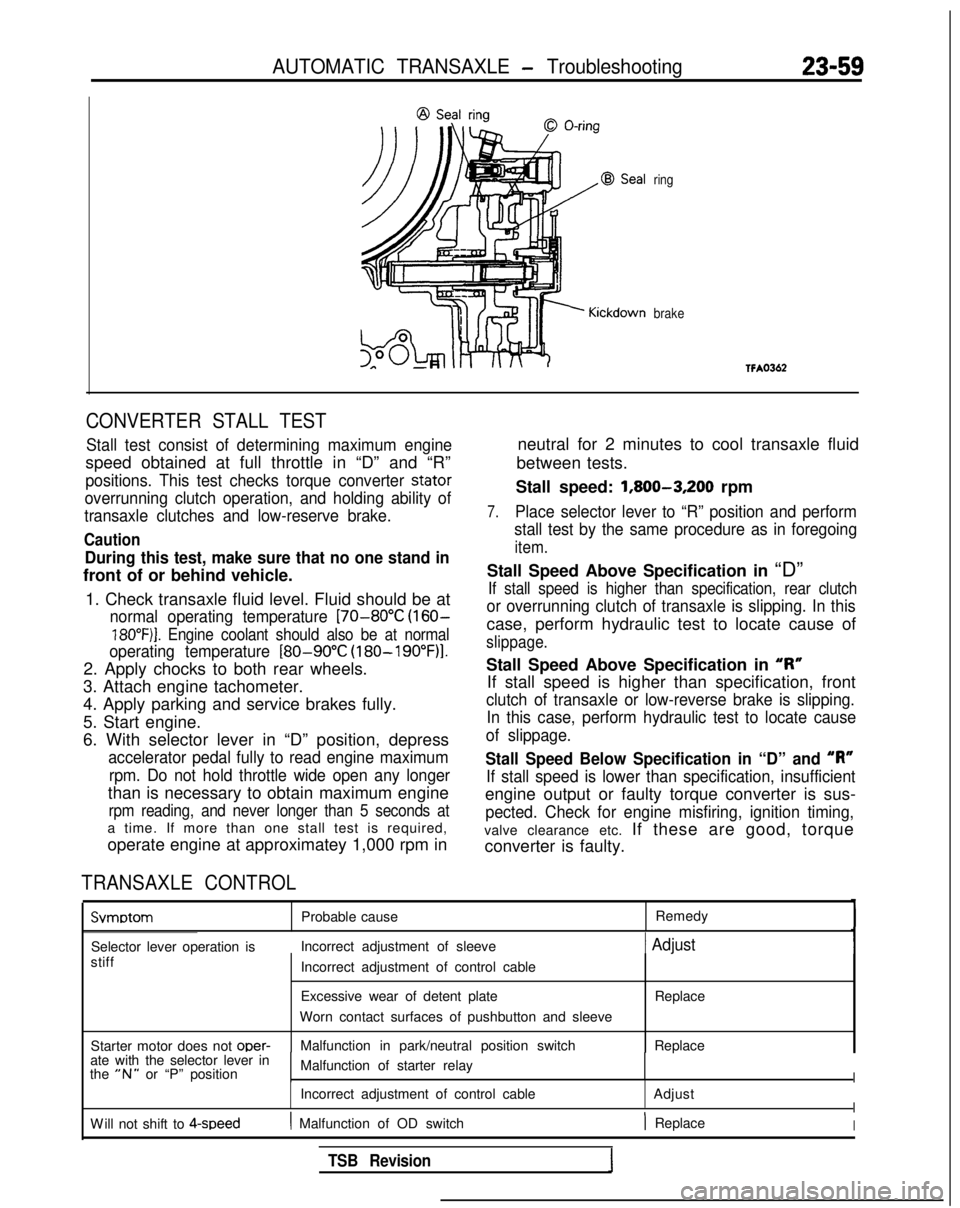
AUTOMATIC TRANSAXLE - Troubleshooting23-59
ring
brake
CONVERTER STALL TEST
Stall test consist of determining maximum engine
speed obtained at full throttle in “D” and “R”
positions. This test checks torque converter stator
overrunning clutch operation, and holding ability of
transaxle clutches and low-reserve brake.
Caution
During this test, make sure that no one stand in
front of or behind vehicle.
1. Check transaxle fluid level. Fluid should be at
normal operating temperature [70-80°C (160-
18O”F)j. Engine coolant should also be at normal
operating temperature
[80-90°C (180-19O”F)l.
2. Apply chocks to both rear wheels.
3. Attach engine tachometer.
4. Apply parking and service brakes fully.
5. Start engine.
6. With selector lever in “D” position, depress
accelerator pedal fully to read engine maximum
rpm. Do not hold throttle wide open any longer
than is necessary to obtain maximum engine
rpm reading, and never longer than 5 seconds at
a time. If more than one stall test is required,
operate engine at approximatey 1,000 rpm in
TRANSAXLE CONTROL
neutral for 2 minutes to cool transaxle fluid
between tests.
Stall speed: 1,800-3,200
rpm
7.Place selector lever to “R” position and perform
stall test by the same procedure as in foregoing
item.
Stall Speed Above Specification in “D”
If stall speed is higher than specification, rear clutch
or overrunning clutch of transaxle is slipping. In this
case, perform hydraulic test to locate cause of
slippage.
Stall Speed Above Specification in “I?”
If stall speed is higher than specification, front
clutch of transaxle or low-reverse brake is slipping. In this case, perform hydraulic test to locate cause
of slippage.
Stall Speed Below Specification in “D” and “R”
If stall speed is lower than specification, insufficient
engine output or faulty torque converter is sus-
pected. Check for engine misfiring, ignition timing,
valve clearance etc. If these are good, torque
converter is faulty. Svmotom
Probable cause
Remedy
Selector lever operation is Incorrect adjustment of sleeve
1 Adjust
stiff
Starter motor does not oper-
Incorrect adjustment of control cable
Excessive wear of detent plate
Worn contact surfaces of pushbutton and sleeve
Malfunction in park/neutral position switch Replace
Replace
ate with the selector lever in
the
“N” or “P” position Malfunction of starter relayI
Incorrect adjustment of control cable
AdjustI
W
ill not shift to 4-speed
( Malfunction of OD switch) ReplaceI
TSB Revision
Page 788 of 1273
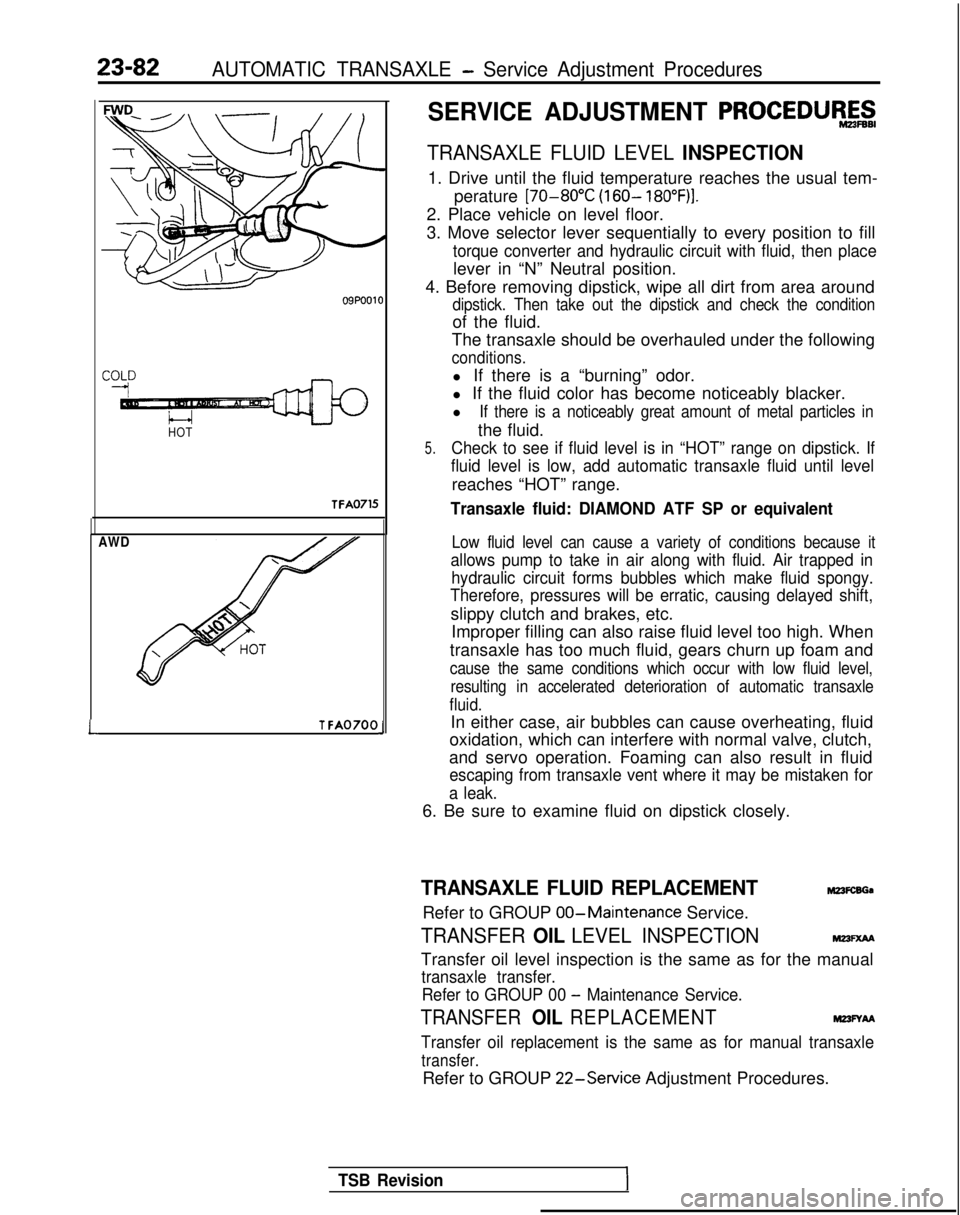
23-82AUTOMATIC TRANSAXLE - Service Adjustment Procedures
HOTTFA0715
AWD
LT FA0700J
SERVICE ADJUSTMENT PROCEDUR&g
TRANSAXLE FLUID LEVEL INSPECTION
1. Drive until the fluid temperature reaches the usual tem-
perature [70-80°C
(160- 18O”F)I.
2. Place vehicle on level floor.
3. Move selector lever sequentially to every position to fill
torque converter and hydraulic circuit with fluid, then place
lever in “N” Neutral position.
4. Before removing dipstick, wipe all dirt from area around
dipstick. Then take out the dipstick and check the condition
of the fluid.
The transaxle should be overhauled under the following
conditions.
l If there is a “burning” odor.
l If the fluid color has become noticeably blacker.
l
If there is a noticeably great amount of metal particles in
the fluid.
5.Check to see if fluid level is in “HOT” range on dipstick. If
fluid level is low, add automatic transaxle fluid until level
reaches “HOT” range.
Transaxle fluid: DIAMOND ATF SP or equivalent
Low fluid level can cause a variety of conditions because it
allows pump to take in air along with fluid. Air trapped in hydraulic circuit forms bubbles which make fluid spongy.
Therefore, pressures will be erratic, causing delayed shift,
slippy clutch and brakes, etc.
Improper filling can also raise fluid level too high. When
transaxle has too much fluid, gears churn up foam and
cause the same conditions which occur with low fluid level, resulting in accelerated deterioration of automatic transaxle
fluid.
In either case, air bubbles can cause overheating, fluid
oxidation, which can interfere with normal valve, clutch,
and servo operation. Foaming can also result in fluid
escaping from transaxle vent where it may be mistaken for
a leak.
6. Be sure to examine fluid on dipstick closely.
TRANSAXLE FLUID REPLACEMENTM23FcsGa
Refer to GROUP 00-Maintenance
Service.
TRANSFER OIL LEVEL INSPECTIONMm=xM
Transfer oil level inspection is the same as for the manual
transaxle transfer.
Refer to GROUP 00
- Maintenance Service.
TRANSFER OIL REPLACEMENTM23FYAA
Transfer oil replacement is the same as for manual transaxle
transfer.
Refer to GROUP 22-Service
Adjustment Procedures.
TSB Revision
Page 799 of 1273
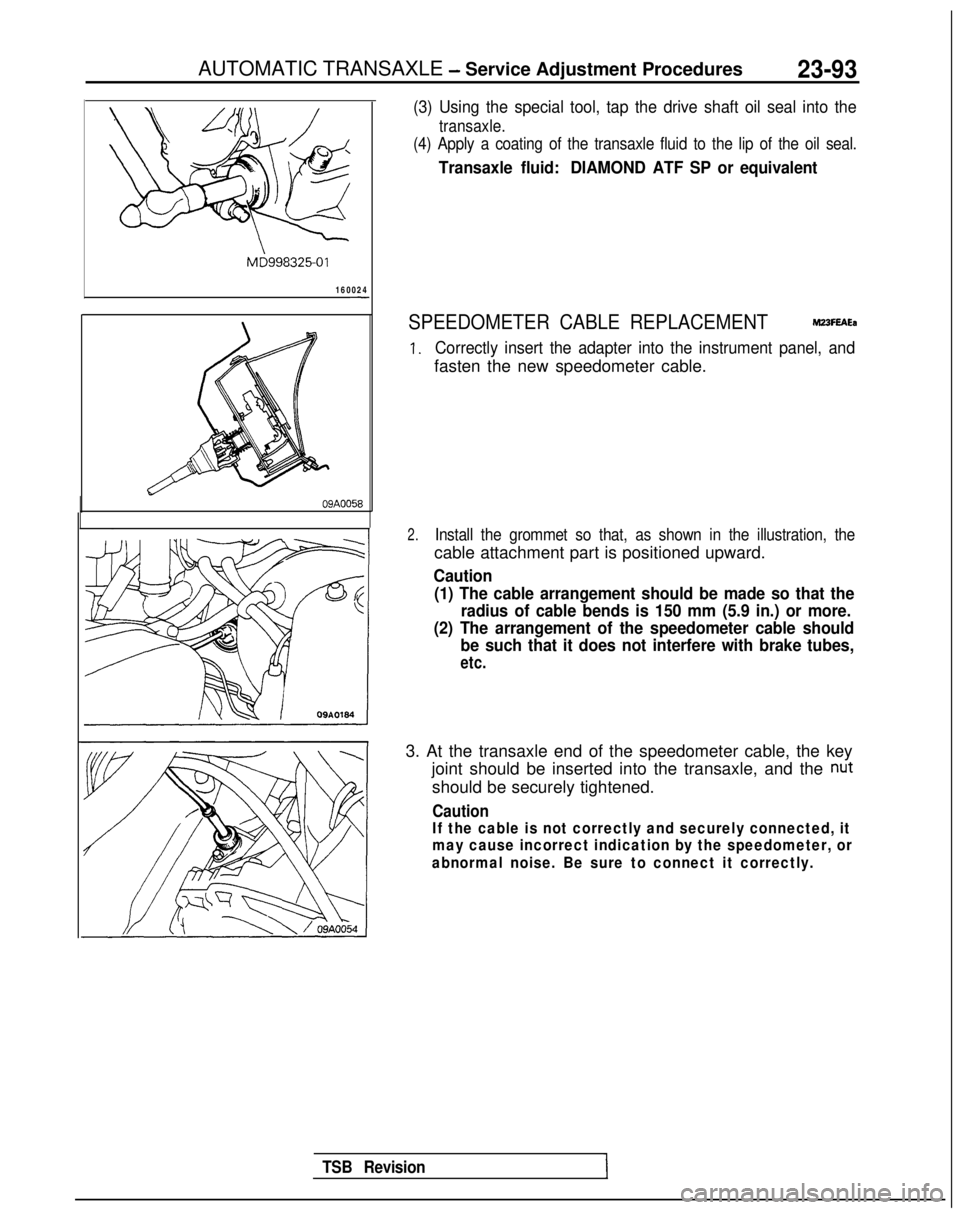
AUTOMATIC TRANSAXLE - Service Adjustment Procedures23-93
MD998325-01
160024
-
(3) Using the special tool, tap the drive shaft oil seal into the
transaxle.
(4) Apply a coating of the transaxle fluid to the lip of the oil seal.\
Transaxle fluid: DIAMOND ATF SP or equivalent
SPEEDOMETER CABLE REPLACEMENTMUFEAEa
1.Correctly insert the adapter into the instrument panel, and
fasten the new speedometer cable.
TSB Revision
2.Install the grommet so that, as shown in the illustration, the
cable attachment part is positioned upward.
Caution
(1) The cable arrangement should be made so that the radius of cable bends is 150 mm (5.9 in.) or more.
(2) The arrangement of the speedometer cable should be such that it does not interfere with brake tubes,
etc.
3. At the transaxle end of the speedometer cable, the key
joint should be inserted into the transaxle, and the
nut
should be securely tightened.
Caution
If the cable is not correctly and securely connected, it
may cause incorrect indication by the speedometer, or
abnormal noise. Be sure to connect it correctly.
Page 1122 of 1273
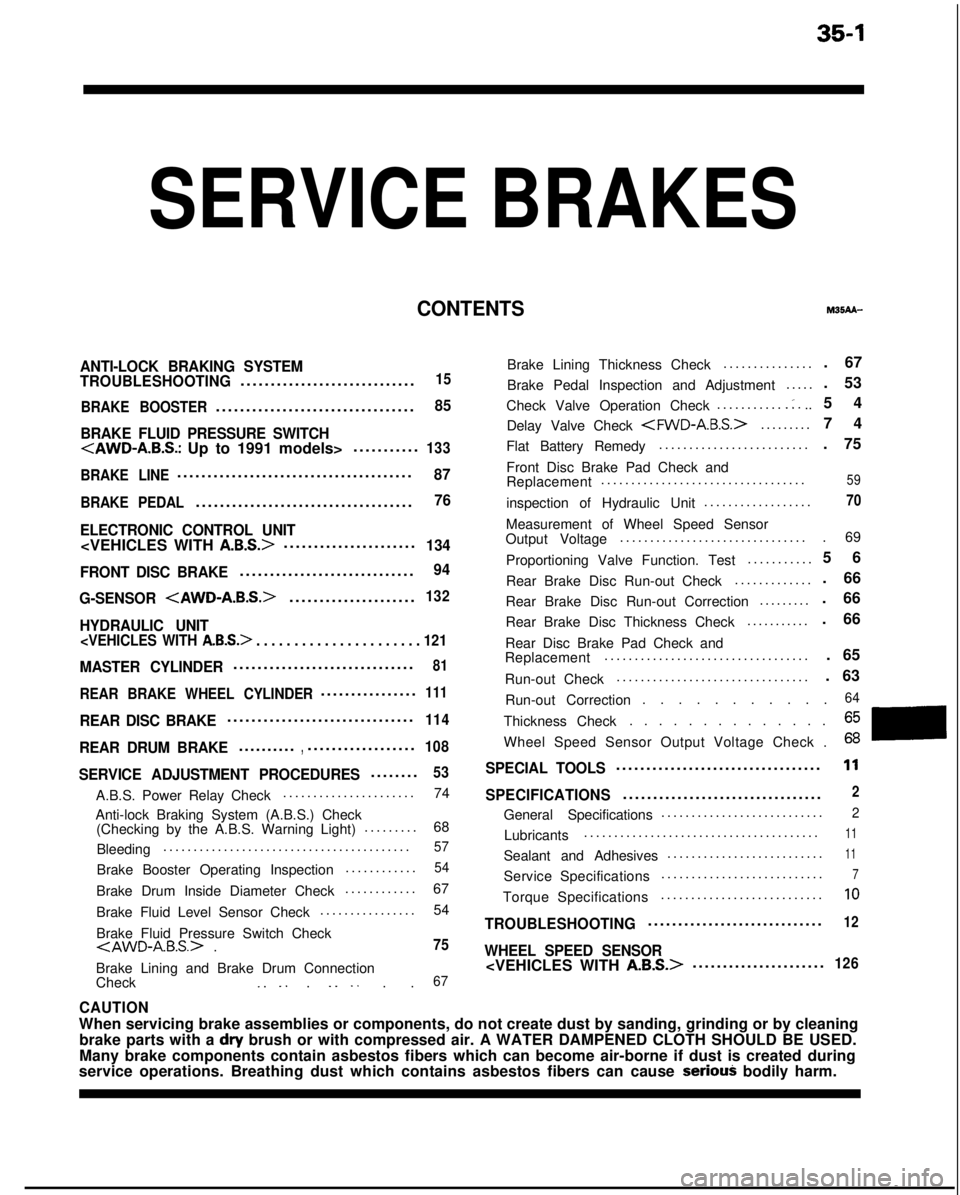
35-1
SERVICE BRAKES
CONTENTSM35AA-
ANTI-LOCK BRAKING SYSTEM
TROUBLESHOOTING............................
.
15
BRAKE BOOSTER
................................
.
85
BRAKE FLUID PRESSURE SWITCH
.
133
BRAKE LINE
......................................
.
87
BRAKE PEDAL...................................
.
76
ELECTRONIC CONTROL UNIT
......................134
FRONT DISC BRAKE
............................
.
94
G-SENSOR
.
132
HYDRAULIC UNIT
. . . . . . . . . . . . . . . . . . . . . . 121
MASTER CYLINDER.............................
.
81
REAR BRAKE WHEEL CYLINDER...............
.
111
REAR DISC BRAKE..............................
.
114
REAR DRUM BRAKE.........
.
,.................
.
108
SERVICE ADJUSTMENT PROCEDURES.......
.
53
A.B.S. Power Relay Check
.....................
.
74
Anti-lock Braking System (A.B.S.) Check (Checking by the A.B.S. Warning Light) .........
68
Bleeding .........................................
57
Brake Booster Operating Inspection
...........
.
54
Brake Drum Inside Diameter Check
...........
.
67
Brake Fluid Level Sensor Check ................
54
Brake Fluid Pressure Switch Check
Brake Lining and Brake Drum Connection
Check _. _. . _. _. . .67
Brake Lining Thickness Check ..............
.
Brake Pedal Inspection and Adjustment .....
Check Valve Operation Check ...........
.:...
Delay Valve Check
.
Flat Battery Remedy .........................
Front Disc Brake Pad Check and
Replacement ..................................
inspection of Hydraulic Unit ..................
Measurement of Wheel Speed Sensor
Output Voltage ...............................
Proportioning Valve Function. Test ...........
Rear Brake Disc Run-out Check .............
Rear Brake Disc Run-out Correction .........
Rear Brake Disc Thickness Check ...........
Rear Disc Brake Pad Check and
Replacement ..................................
Run-out Check ................................ . 67
. 53
54
74
. 75
59
70
. 69
5
6
. 66
. 66
. 66
. 65
. 63
Run-out Correction . . . . . . . . . . .
64
Thickness Check. . . . . . . . . . . . . .
Wheel Speed Sensor Output Voltage Check .
SPECIAL TOOLS.................................
.
11
SPECIFICATIONS................................
.
2
General Specifications
..........................
.
2
Lubricants
......................................
.
11
Sealant and Adhesives
.........................
.
11
Service Specifications
..........................
.
7
Torque Specifications
..........................
.
10
TROUBLESHOOTING............................
.
12
WHEEL SPEED SENSOR
.
126
CAUTION
When servicing brake assemblies or components, do not create dust by san\
ding, grinding or by cleaning
brake parts with a
dry brush or with compressed air. A WATER DAMPENED CLOTH SHOULD BE USED.
Many brake components contain asbestos fibers which can become air-borne\
if dust is created during
service operations. Breathing dust which contains asbestos fibers can ca\
use
seriouj bodily harm.
Page 1132 of 1273
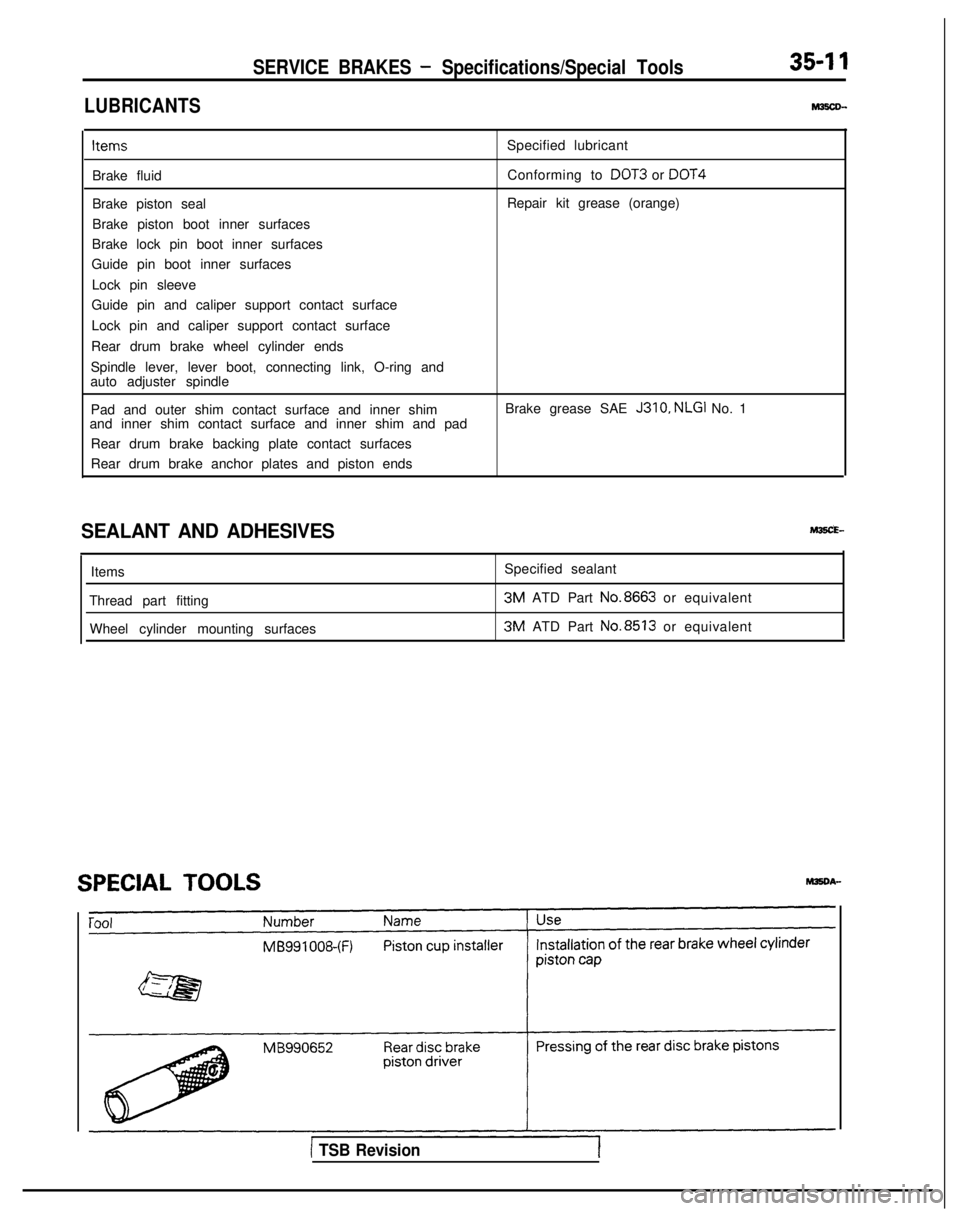
SERVICE BRAKES - Specifications/Special Tools35-l 1
LUBRICANTS
Items
Brake fluid
Brake piston seal
Brake piston boot inner surfaces
Brake lock pin boot inner surfaces
Guide pin boot inner surfaces
Lock pin sleeve
Guide pin and caliper support contact surface
Lock pin and caliper support contact surface
Rear drum brake wheel cylinder ends
Spindle lever, lever boot, connecting link, O-ring and
auto adjuster spindle Specified lubricant
Conforming to
DOT3 or DOT4
Repair kit grease (orange)
Pad and outer shim contact surface and inner shim
and inner shim contact surface and inner shim and pad
Rear drum brake backing plate contact surfaces
Rear drum brake anchor plates and piston ends Brake grease SAE J310,
NLGI No. 1
SEALANT AND ADHESIVES
,
Items
Specified sealant
Thread part fitting 3M
ATD Part No.8663
or equivalent
Wheel cylinder mounting surfaces 3M
ATD Part No.8513
or equivalent
SPECIAL TOOLS
[ TSB Revision
Page 1134 of 1273

SERVICE BRAKES - Troubleshooting35-13
SymptomInsufficient braking
power Probable cause
Low or deteriorated brake fluid
Air in brake system Overheated brake rotor due to dragging of pad or
lining Remedy
Refill or change
Bleed air
Correct
Inadequate contact of pad or lining
Brake booster malfunction
Clogged brake line
Grease or oil on pad or lining surface
Replace
Proportioning valve malfunction
Auto adjuster malfunction Adjust
Increased pedal stroke Air in brake system Bleed air’
(Reduced pedal to floor-
board clearance) Worn lining or pad
Replace
Broken vacuum hose
Faulty master cylinder
Brake fluid leaks Correct
Auto adjuster malfunction Adjust
Excessive push rod to master cylinder clearance
Brake dragIncomplete release of parking brake Correct
Clogged master cylinder return port Incorrect parking brake adjustment Adjust
Improper push rod to master cylinder clearance
Faulty master cylinder piston return spring
Replace
Worn brake pedal return spring Broken rear drum brake shoe return spring
Lack of lubrication in sliding parts Lubricate
Insufficient parking Worn brake lining or pad
Replace
Drake function
Grease or oil on lining or pad surface
Parking brake cable sticking
Stuck wheel cylinder or caliper piston
Excessive parking brake lever stroke Adjust the parking brake lever
stroke or check the parking brake
cable routing
Auto adjuster malfunction Adjust
TSB Revision
-..